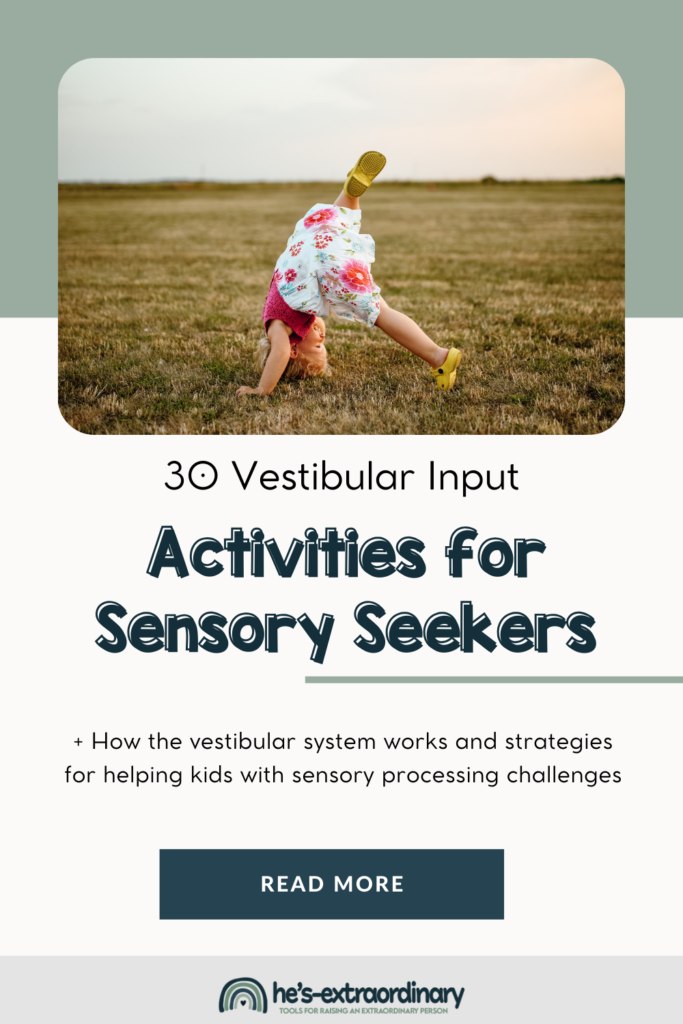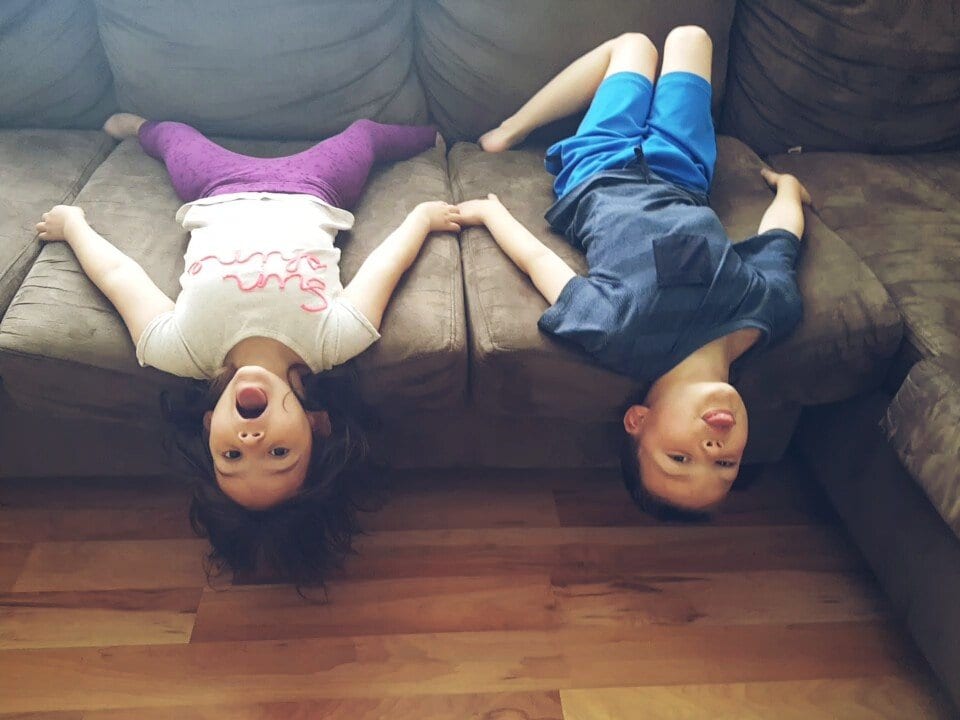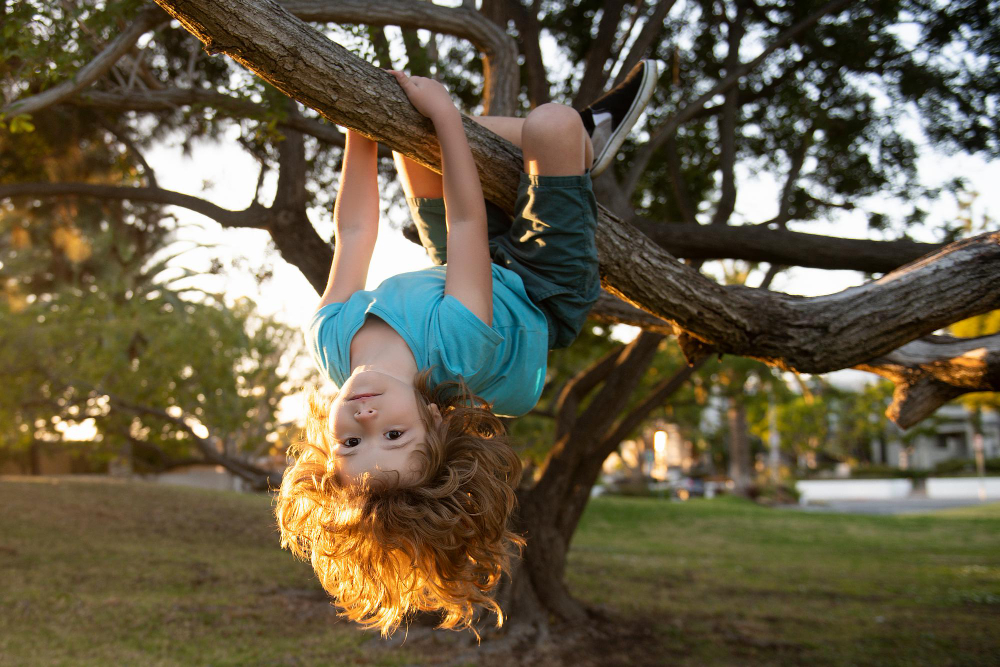The Vestibular System – 27 Vestibular Input Activities
What’s inside this article: An in-depth explanation of how the vestibular system works, types of sensory processing issues related to the vestibular system, an explanation of what causes dizziness, and vestibular input activities for children.
Disclaimer: This post contains affiliate links.
Sensory play is an essential part of childhood development. Our senses provide us with vital information thousands of times per day. Starting from birth, children use their senses to explore and learn about the world around them.
Vestibular input activities can provide some of the best stimulation for active sensory-seeking kids, which can keep their sensory needs met for hours.
This post is part of a 10-part series on the sensory systems. Each part will contain a table of contents to help you easily navigate through the entire series.
Table of Contents:
- Introduction – The Sensory Spectrum
- The Tactile System
- The Auditory System
- The Visual System
- Proprioception
- Vestibular System
- Interoception
- The Olfactory System
- The Oral-Motor System
- Bilateral Coordination
It’s so important to provide opportunities for sensory play for your kids every single day.
There are many benefits for kiddos with autism to engage in regular sensory play, including:
- Cognitive development
- Brain development
- Improved emotional regulation
- Enhanced learning
How Does the Vestibular System Work?
The vestibular system is your sense of movement.
The organs that control the vestibular system are located in the inner ear and include the vestibular nerve and the semicircular canals.
Below is a diagram of the ear to help you visualize and understand how this complex sensory system works.

The semicircular canals are three tiny fluid-filled tubes located in the inner ear, and they are part of the vestibular system. Their job is to help you maintain your balance.
When you move your head around, the fluid inside these tubes moves over tiny hairs inside the canals. This creates nerve messages sent to your brain, which lets your brain know what you need to do in order to stay balanced.
The vestibular nerve transmits sensory information to the brain based on the position of the head in relation to the body. It plays a role in balance and motor planning.
Two other parts of the vestibular system are shown below – the utricle and saccule. This diagram is basically a zoomed-in version of the semicircular canals.
The saccule and the utricle are both beds of sensory cells that detect linear movement.
The saccule detects horizontal movements, and the utricle detects vertical movements.
The vestibular system is really complicated, and these are just the basics. But, together, these parts of the inner ear work to keep us balanced, coordinated, and aware of our body movements.
The vestibular system works very closely with the proprioceptive system to control movements.
Sensory Integration Problems Related to The Vestibular System
The warning signs that something is off with the vestibular system are often mistaken as behavioral issues.
It may lead to academic problems, issues with muscle development, and issues with attention.
Also, it may be the reason why a child is stimming because they feel a need to move to stimulate this system. However, for others, movement can cause anxiety and nausea.
As always, if you’re concerned that your child is dealing with sensory processing issues related to the vestibular system, an occupational therapist who specializes in sensory integration therapy can help evaluate and address these challenges.
The following are some of the common signs that your child is struggling with vestibular processing issues.
Sensory Discrimination or Perception Issues
Discrimination and perception issues occur when the brain is struggling to interpret and give meaning to sensory input.
- Poor balance
- Seems easily disoriented
- Difficulty perceiving motion. For example, they wouldn’t be able to tell what direction they were falling (they wouldn’t put their arms out in the correct direction to catch themselves) – Or may not feel when they start falling at all.
- Odd posture
- Clumsiness. For example, frequently but unintentionally bumps into objects and people
Modulation Issues
Occurs when the brain over- or under-responds to sensory input.
Over-Responsive (Vestibular Defensiveness/Avoidance)
- Afraid of slides, swings, merry-go-rounds, etc.
- Dislikes or avoids elevators and escalators
- Sedentary – they avoid activities that involve a lot of movement
- May worry about falling even when there is no risk of it.
- Worries or is afraid of using the
stairs or walking on uneven surfaces - Dislikes jumping or any activity where the feet leave the ground
- Startles if someone unexpectedly moves them (like pushing their chair in closer to the table)
Under-Responsive (Vestibular Input Seeking)
- Hyperactive – always in motion
- Jumps all over the furniture constantly. For example, even when interested in a TV show, it seems they can’t sit still. Instead, they must be moving, upside down, bouncing, rocking into the cushions, etc.
- Loves spinning, seems never to get dizzy
- Craves intense movement experiences. For example, loves rides at an amusement park or spinning in an office chair
- Loves swinging, slides, hanging upside down, etc.
Praxis Issues
Praxis issues are related to planning and executing motor movements that the body has not done before.
Therefore, Praxis problems related to the vestibular system involve issues with balance and motor planning.
- Struggles with new athletic activities sports, riding a bike, climbing
- Needs extra time to plan motor movements, slow
- Poor performance in gym class
- May take additional time to learn even simple motor movements. For example, waving
- Late meeting developmental milestones related to movement, such as crawling, walking, standing, etc.
Vestibular Bilateral Coordination Issues
These are issues related to coordinating both sides of the body. Bilateral coordination is covered in more detail here.
Signs may include things such as:
- Trouble stabilizing a piece of paper with one hand while writing with the other
- Unable to pedal a bike – cannot coordinate moving the left foot and right foot on the pedals
- Trouble performing jumping jacks, jumping rope, catching a ball with both hands
- Struggles with alternating movements, such as marching, swimming, beating a drum
- Trying to do an activity using only one hand that requires two hands.
Related: Calm Down by Hanging Upside Down
What Causes Dizziness?
This is more of a side note, but I wanted to include it because it’s super fascinating, and so many kids with sensory needs love to spin!
I can feel dizzy just watching my kids spin, but they can spin relentlessly without getting dizzy.
As mentioned earlier, the semicircular canals are fluid-filled and send signals to your brain based on the position of your head to help you maintain your balance.
When you’re spinning, this fluid is moving around and around, just like you are.
When you stop moving, the fluid in your semicircular canals keeps moving (Like when you make a whirlpool inside a water bottle); and it takes a while for the fluid to settle.
So, while it’s moving over those tiny hairs, signals are being sent to your brain as if you were still spinning, which causes you to feel dizzy and have problems with your balance.
Vestibular Input Activities For Sensory Seekers
The best vestibular input activities for kids are ones
Kids can usually find a way to do this themselves, but it’s often in a way that’s undesirable for us (like doing somersaults on the sofa) or a distraction to people around them.
Planned activities at regular intervals throughout the day can prevent sensory-seeking behavior when it’s most important – like during class when you want your kiddo to stay in their seat.
Occupational therapists often recommend “sensory snacks”, which is an activity that is 5-10 minutes long every 1-2 hours.

Here are some ideas vestibular input ideas to get you started:
Hanging Upside Down
This is one of my favorite activities to recommend to anyone with sensory-seeking kids. Read here about how you can actually help kids calm down by hanging upside down.
There are many ways you can do this: let your kids hang off the couch, the monkey bars, or set them on your lap and slowly lower them backward by their arms.
The amount of vestibular input the brain receives from hanging upside down is really powerful because it’s such a unique experience.
It can help keep sensory seekers calm for hours.

Some kids are sensitive to hanging upside down, so never push your child to do something they don’t want to do.
Spinning
As I mentioned, spinning is a great vestibular input activity, and depending on your child and how sensitive they are to becoming dizzy, you may be able to do activities with faster spinning, or you may need to do slower, more rhythmic spinning activities.
- Spin your child around in an office chair
- Play ring around the Rosie
- Roll down a big grassy hill
- For toddlers: the Sit n Spin
- For older kids: the Dizzy Disc
- Get your child to lay on their belly on a swing, twist it up, and then let it go.
Games you can play at home
Whether you’re inside or outside, there are tons of games you can play at home to get your kids moving for lots of vestibular input.
- Freeze dance
- Put shoeboxes on your feet and go “skating” around the house
- Play Simon says
- Push your child around on a scooter board
- Jump on a mini trampoline
- Make a tire swing for your yard, or get an indoor swing (read: beyond play – the benefits of swinging)
- Make an indoor obstacle course – use furniture, make lines with some tape they must walk on, or tape across doorways to crawl under, etc. (This is great for a laid-back rainy day but not an activity I could personally do every day)
- Hopscotch
- Jump rope
- Blow bubbles outside and have your kids run around trying to pop them
- Play a game of tag
- Bounce on a stability ball
- Get your child a rocking chair
Workouts for Kids
Short, fun workouts for kids can provide a burst of sensory input along with other health benefits, too.
I have three free printable workouts for kids, which you can get here:
Activities for when you can’t get up and move around
It can be exceptionally difficult for kids who are active sensory seekers to sit still – like in the classroom, long car rides, and waiting rooms.
You should try to plan vestibular input activities before periods of time when kids are expected to sit. This will reduce their need for fidgeting and movement.
But what can you do when you can’t get up and move around, but your child is struggling?
- Get them to imitate your head movements – tilt your head up and down, left and right, or shake it back and forth and get your child to copy you. The vestibular system is located in the inner ear, and this will give some sensory input without moving the rest of the body.
- For school or appointments, try bringing along an inflatable wobble disk for their seat – this will help your child’s core strength and balance and also allow them to wiggle around in their seats without being noisy and distracting the people around them.
Vestibular Input Strategies for Over-Responsiveness
For a child with a hypersensitive vestibular system, specific activities should be designed to help them gradually adapt to movement and reduce avoidance behaviors.
Some activities might include:
- Balance exercises: Simple tasks like standing on one foot or using a balance board, or going through a calming yoga sequence.
- Slow, gentle, or rhythmic swinging. A hammock or cuddle swing may help them swing in a more comfortable, controlled manner.
- Climbing and crawling activities – allow kids to move at their own pace when crawling and climbing through playground equipment or tunnels.
- Heavy work activities (which provide proprioceptive input) can be grounding for kids with a hypersensitive vestibular system.
- Don’t force your child to participate in activities that will cause overstimulation. An
over-stimulated vestibular systemcan cause behavioral issues that can last for hours.
When introducing new activities to kids with sensory challenges related to the vestibular system, it’s important to introduce activities slowly and monitor the child’s reaction, always prioritizing their comfort level.
Working with an occupational therapist to develop an individualized plan can be very beneficial.


